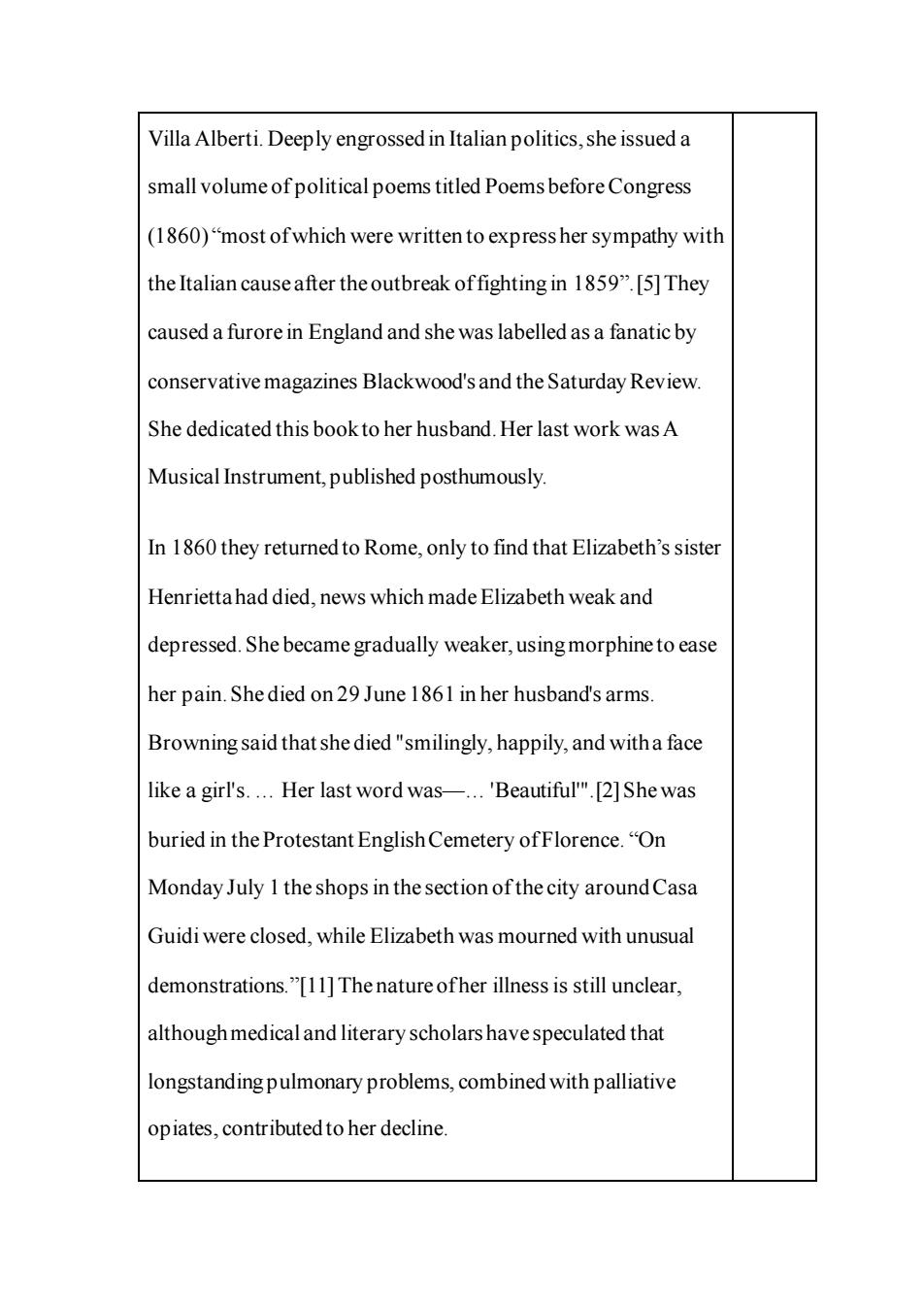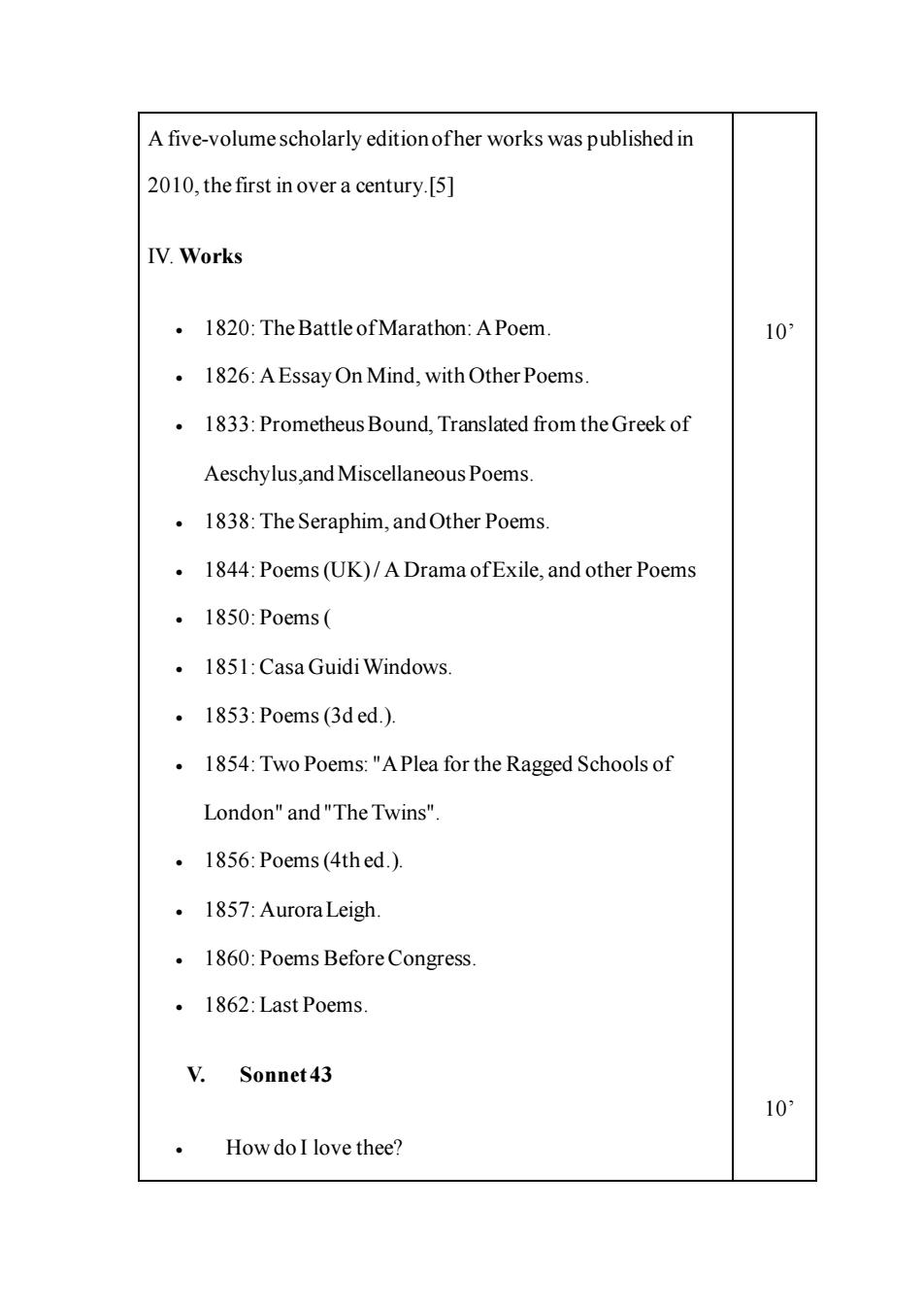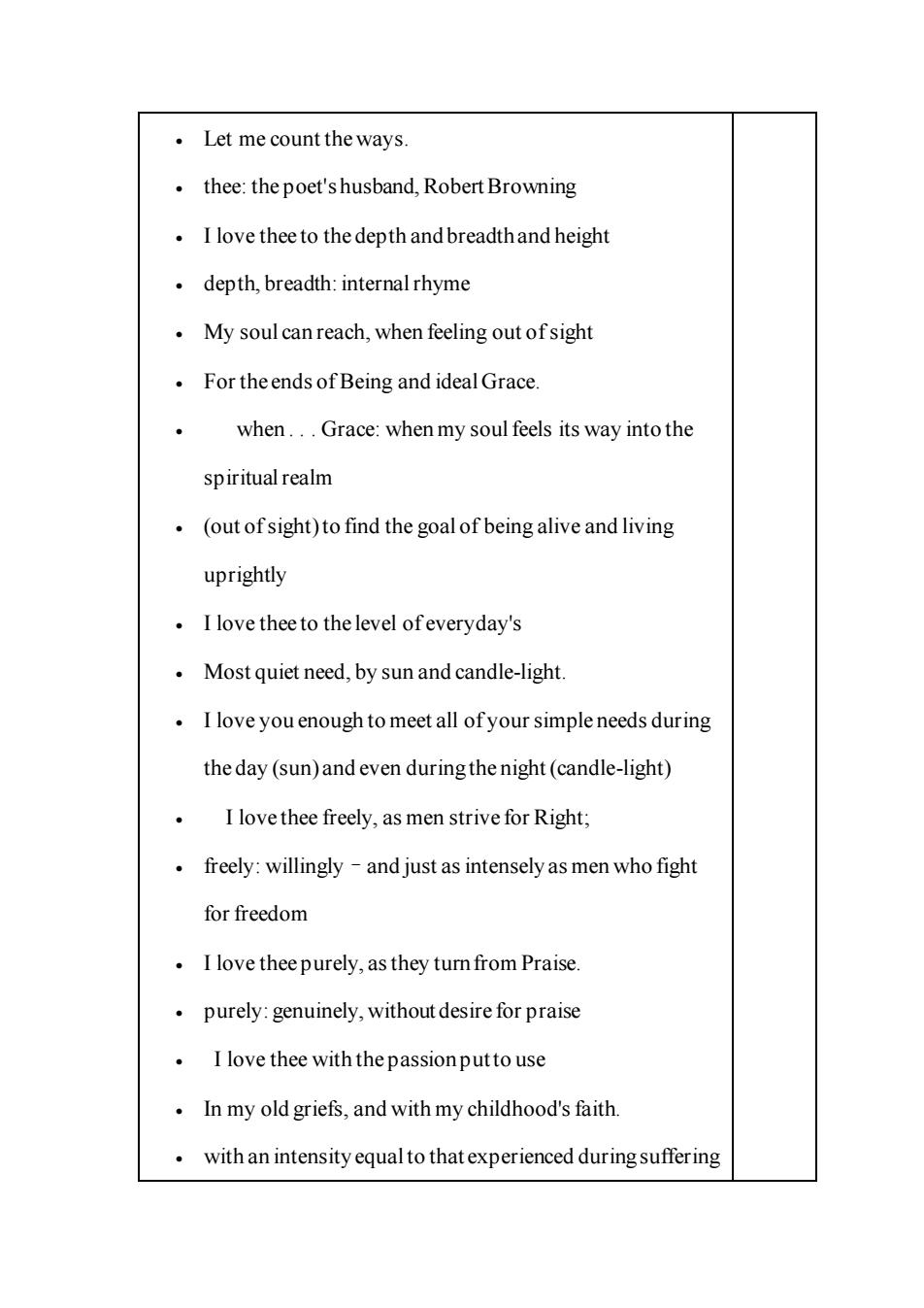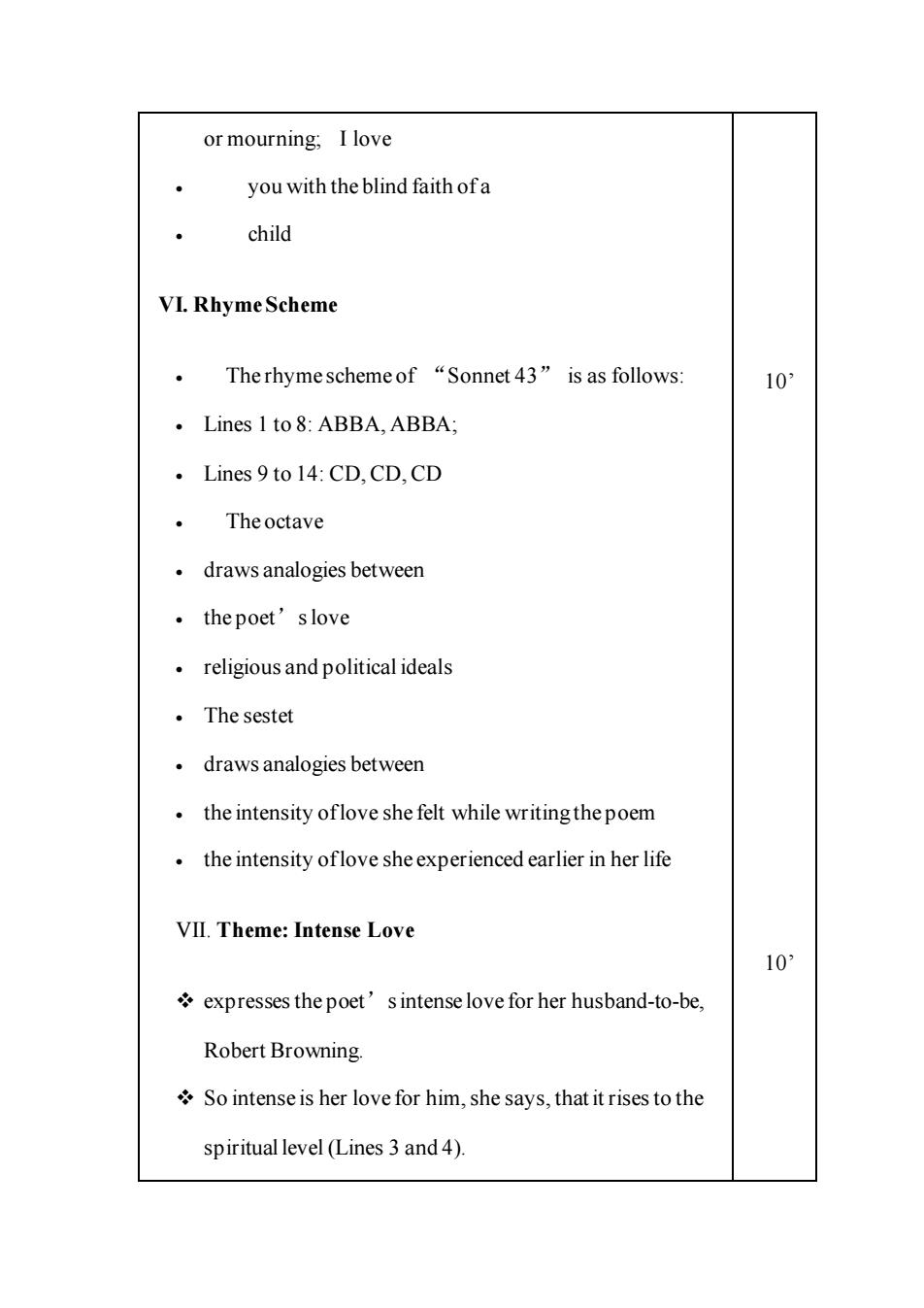
教案 课程名称 英国文学 授课专业和班级 英语本科 授课内容 Elizabeth Barrett Browning 授课学时 2 To let the students see the significance of literature; 教学目的 To let the students have the general impression of British literature. To let the students get basic knowledge of British literature To get to know the general clue of British literary history 教学重点与 To get to know the important British writers and literary works 难点 To get to know some key terms To know some methods for literary appreciation and criticism 教学方法 s in class 辅助手段 Projector,audio-video machine Elizabeth Barrett Browning Browning's wife,Elizabeth Barrett(1806-61)was also a famous poet ofthe age,better known than her husband during her 10 lifetime.Their love affair was a famous story in English literary history,which evoked a number ofliterary works both in fiction and drama.Nowadays,Mrs.Browning is chiefly remembered fro her love poems Sonnets from the Portuguese(1850)and The Cry of the Children(1843),which exposesthe criminal system of child-labor prevailing in 19th century England.Compared with her husband,Mr.Browning was more radical and liberal in mind
教 案 课程名称 英国文学 授课专业和班级 英语本科 授课内容 Elizabeth Barrett Browning 授课学时 2 教学目的 To let the students see the significance of literature; To let the students have the general impression of British literature. To let the students get basic knowledge of British literature 教学重点与 难点 To get to know the general clue of British literary history To get to know the important British writers and literary works To get to know some key terms To know some methods for literary appreciation and criticism 教学方法 Open questions and answers in class Class discussion and analysis 辅助手段 Projector, audio-video machine Elizabeth Barrett Browning Browning’s wife, Elizabeth Barrett (1806-61) was also a famous poet of the age, better known than her husband during her lifetime. Their love affair was a famous story in English literary history, which evoked a number of literary works both in fiction and drama. Nowadays, Mrs. Browning is chiefly remembered fro her love poems Sonnets from the Portuguese (1850) and The Cry of the Children (1843), which exposes the criminal system of child-labor prevailing in 19th century England. Compared with her husband, Mr. Browning was more radical and liberal in mind 10’

and more concerned about the social problems ofher time I.Life 10 Elizabeth Barrett Moulton-Barrett was bornon 6 March 1806. in Coxhoe Hall,between the villages of Coxhoe and Kelloe in County Durham,England.Her parents were Edward Barrett Moulton Barrett and Mary Graham Clarke:Elizabeth was the eldest oftheir 12 children(eight boys and four girls).All the children lived to adulthood except for one girl,who died at the age ofthree when Elizabeth was eight.The children in her family all had nicknames:Elizabeth's was"Ba".Elizabeth was baptized in 1809 at Kelloe Parish Church,though she had already been baptized by a family friend in the first week after she was born Later that year,after the fifth child,Henrietta,was born,their father bought Hope End,a500-acre(2.0 km2)estatenear the Malvern Hills in Ledbury,Herefordshire,where Elizabethspent her childhood.[2]Her time at Hope End would inspire her in later life to write Aurora Leigh At the death ofanold friend,G.B.Hunter,and then ofher father, her health faded again,centeringaround deteriorating lung function.She was moved from Florence to Siena,residingat the
and more concerned about the social problems of her time. I. Life Elizabeth Barrett Moulton-Barrett was born on 6 March 1806, in Coxhoe Hall, between the villages of Coxhoe and Kelloe in County Durham, England. Her parents were Edward Barrett Moulton Barrett and Mary Graham Clarke; Elizabeth was the eldest of their 12 children (eight boys and four girls). All the children lived to adulthood except for one girl, who died at the age of three when Elizabeth was eight. The children in her family all had nicknames: Elizabeth's was "Ba". Elizabeth was baptized in 1809 at Kelloe Parish Church, though she had already been baptized by a family friend in the first week after she was born. Later that year, after the fifth child, Henrietta, was born, their father bought Hope End, a 500-acre (2.0 km2) estate near the Malvern Hills in Ledbury, Herefordshire, where Elizabeth spent her childhood.[2]Her time at Hope End would inspire her in later life to write Aurora Leigh. At the death of an old friend, G.B. Hunter, and then of her father, her health faded again, centering around deteriorating lung function. She was moved from Florence to Siena, residing at the 10’

Villa Alberti.Deeply ngrossedin Italianpolitics,she issueda small volume of political poems titled Poems before Congress (1860)"most ofwhich were written to express her sympathy with the Italian cause after the outbreak offighting in 1859".[5]They caused a furore in England and she was labelled as a fanatic by conservative magazines Blackwood's and the Saturday Review She dedicated this book to her husband.Her last work wasA Musical Instrument,published posthumously. In 1860 they returned to Rome,only to find that Elizabeth's sister Henriettahad died,news which made Elizabeth weak and depressed.She became gradually weaker,using morphine to ease her pain.She died on 29 June 1861 in her husband's arms Browning said that she died "smilingly,happily,and witha face like a girl's.Her last word was-.'Beautiful'".[2]She was buried in the Protestant English Cemetery ofFlorence."On Monday July 1 the shops in the section of the city around Casa Guidi were closed,while Elizabeth was mourned with unusual demonstrations."[11]The nature ofher illness is still unclear, although medical and literary scholars have speculated that longstanding pulmonary problems,combined with palliative opiates,contributed to her decline
Villa Alberti. Deeply engrossed in Italian politics, she issued a small volume of political poems titled Poems before Congress (1860) “most of which were written to express her sympathy with the Italian cause after the outbreak of fighting in 1859”.[5]They caused a furore in England and she was labelled as a fanatic by conservative magazines Blackwood's and the Saturday Review. She dedicated this book to her husband. Her last work was A Musical Instrument, published posthumously. In 1860 they returned to Rome, only to find that Elizabeth’s sister Henrietta had died, news which made Elizabeth weak and depressed. She became gradually weaker, using morphine to ease her pain. She died on 29 June 1861 in her husband's arms. Browning said that she died "smilingly, happily, and with a face like a girl's. . Her last word was—. 'Beautiful'".[2] She was buried in the Protestant English Cemetery of Florence. “On Monday July 1 the shops in the section of the city around Casa Guidi were closed, while Elizabeth was mourned with unusual demonstrations.”[11]The nature of her illness is still unclear, although medical and literary scholars have speculated that longstanding pulmonary problems, combined with palliative opiates, contributed to her decline

II.Spiritualinfluence 10 Much of Barrett Browning's work carries a religious theme. She had read and studied such famous literary worksas Milton's Paradise Lost and Dante's Inferno.She says in her writing,"We want the sense ofthe saturation of Christ's blood upon the souls of our poets,that it may cry through them in answer to the ceaseless wail of the Sphinx ofour humanity,expounding agony into renovation.Something ofthis has been perceived in art when its glory was at the fullest.Something ofa yearningafter this may be seen among the Greek Christian poets,something which would have been much with a stronger faculty".[12]She believed that "Christ'sreligion is essentially poetry-poetry glorified".She explored the religious aspect in many ofher poems,especially in her early work,suchas the sonnets.She was interested in theological debate,had learned Hebrew and read the Hebrew Bible.[13]The poem Aurora Leigh,for example,features religious imagery and allusion to theapocalypse. III.Critical reception American poet Edgar Allan Poe was inspired by Barrett 0. Browning's poem Lady Geraldine's Courtship andspecifically
II. Spiritual influence Much of Barrett Browning’s work carries a religious theme. She had read and studied such famous literary works as Milton's Paradise Lost and Dante's Inferno. She says in her writing, "We want the sense of the saturation of Christ's blood upon the souls of our poets, that it may cry through them in answer to the ceaseless wail of the Sphinx of our humanity, expounding agony into renovation. Something of this has been perceived in art when its glory was at the fullest. Something of a yearning after this may be seen among the Greek Christian poets, something which would have been much with a stronger faculty".[12] She believed that "Christ's religion is essentially poetry—poetry glorified". She explored the religious aspect in many of her poems, especially in her early work, such as the sonnets. She was interested in theological debate, had learned Hebrew and read the Hebrew Bible.[13]The poem Aurora Leigh, for example, features religious imagery and allusion to the apocalypse. III. Critical reception American poet Edgar Allan Poe was inspired by Barrett Browning's poem Lady Geraldine's Courtship and specifically 10’ 10’

borrowed thepoem's meter for his poem The Raven.[15]Poe had reviewed Barrett's work in the January 1845 issue ofthe Broadway Journal and said that"her poetic inspirationis the highest-we can conceive of nothingmore august.Her sense of Art is pure in itself."[16]Inreturn,she praised The Raven and Poe dedicated his 1845 collection The Raven and Other Poemsto her,referringto her as"thenoblest ofher sex".[17] Her poetry greatly influenced Emily Dickinson,who admired her as a woman ofachievement.Her popularity in the United States and Britain was further advanced by her stands against social injustice,including slavery in the United States,injustice toward Italian citizens by foreign rulers,and child labour. In Lilian Whiting's 1899biography ofElizabeth she describes her as"themost philosophical poet"and depicts her life as"a Gospel of applied Christianity".To Whiting,theterm"art for art's sake" did not apply to Barrett Browning's work for the reason that each poem,distinctively purposeful,was borne ofa more"honest vision".In this criticalanalysis,Whitingportrays Barrett Browning as a poet who uses knowledge of Classical literature with an"intuitive gift of spiritual divination".[18]In Elizabeth Barrett Browning,Angela Leighton suggests that the portrayal of
borrowed the poem's meter for his poem The Raven.[15] Poe had reviewed Barrett's work in the January 1845 issue of the Broadway Journal and said that "her poetic inspiration is the highest—we can conceive of nothing more august. Her sense of Art is pure in itself."[16]In return, she praised The Raven and Poe dedicated his 1845 collection The Raven and Other Poems to her, referring to her as "the noblest of her sex".[17] Her poetry greatly influenced Emily Dickinson, who admired her as a woman of achievement. Her popularity in the United States and Britain was further advanced by her stands against social injustice, including slavery in the United States, injustice toward Italian citizens by foreign rulers, and child labour. In Lilian Whiting's 1899 biography of Elizabeth she describes her as "the most philosophical poet" and depicts her life as "a Gospel of applied Christianity". To Whiting, the term "art for art's sake" did not apply to Barrett Browning's work for the reason that each poem, distinctively purposeful, was borne of a more "honest vision". In this critical analysis, Whiting portrays Barrett Browning as a poet who uses knowledge of Classical literature with an "intuitive gift of spiritual divination".[18]In Elizabeth Barrett Browning, Angela Leighton suggests that the portrayal of

Barrett Browning as the "pious iconography ofwomanhood"has distracted us from her poetic achievements.Leighton cites the 1931 play by RudolfBesier,The Barretts of Wimpole Street,as evidence that 20thcentury literary criticism ofBarrett Browning's work has suffered more as a result of her popularity than poetic ineptitude.[19]The play waspopularized by actress Katharine Cornell,for whom it became a signature role.It was an enormous success,both artistically and commercially,and was revived several times and adapted twice into movies. Throughout the 20th century,literary criticism of Barrett Browning's poetry remained sparse until her poems were discovered by the women's movement.She once described herself as being inclined to reject several women's rights principles, suggesting in letters to Mary Russell Mitford and her husband that she believed that there was an inferiority ofintellect in women.In Aurora Leigh,however,she created a strongand independent woman who embraces both work and love.Leighton writes that because she participates in the literary world,where voice and diction are dominated by perceived masculine superiority,she"is defined only in mysteriousopposition to everything that distinguishes the male subject who writes."[19]
Barrett Browning as the "pious iconography of womanhood" has distracted us from her poetic achievements. Leighton cites the 1931 play by Rudolf Besier, The Barretts of Wimpole Street, as evidence that 20th century literary criticism of Barrett Browning's work has suffered more as a result of her popularity than poetic ineptitude.[19]The play was popularized by actress Katharine Cornell, for whom it became a signature role. It was an enormous success, both artistically and commercially, and was revived several times and adapted twice into movies. Throughout the 20th century, literary criticism of Barrett Browning's poetry remained sparse until her poems were discovered by the women's movement. She once described herself as being inclined to reject several women's rights principles, suggesting in letters to Mary Russell Mitford and her husband that she believed that there was an inferiority of intellect in women. In Aurora Leigh, however, she created a strong and independent woman who embraces both work and love. Leighton writes that because she participates in the literary world, where voice and diction are dominated by perceived masculine superiority, she "is defined only in mysterious opposition to everything that distinguishes the male subject who writes."[19]

A five-volume scholarly editionofher works was published in 2010,the first in over a century.[5] IV.Works 1820:The Battle ofMarathon:A Poem. 10 。 1826:A Essay On Mind,with Other Poems. 1833:Prometheus Bound,Translated from the Greek of Aeschylus,and Miscellaneous Poems. 1838:The Seraphim,and Other Poems. 1844:Poems(UK)/A Drama ofExile,and other Poems 。 1850:Poems( 1851:Casa Guidi Windows. ·1853:Poems(3ded) 1854:Two Poems:"A Plea for the Ragged Schools of London"and"The Twins" ·1856:Poems(4thed.) ·1857:Aurora Leigh. 1860:Poems Before Congress ·1862:Last Poems V.Sonnet43 10 How doI love thee?
A five-volume scholarly edition of her works was published in 2010, the first in over a century.[5] IV. Works • 1820: The Battle of Marathon: A Poem. • 1826: A Essay On Mind, with Other Poems. • 1833: Prometheus Bound, Translated from the Greek of Aeschylus,and Miscellaneous Poems. • 1838: The Seraphim, and Other Poems. • 1844: Poems (UK) / A Drama of Exile, and other Poems • 1850: Poems ( • 1851: Casa Guidi Windows. • 1853: Poems (3d ed.). • 1854: Two Poems: "A Plea for the Ragged Schools of London" and "The Twins". • 1856: Poems (4th ed.). • 1857: Aurora Leigh. • 1860: Poems Before Congress. • 1862: Last Poems. V. Sonnet 43 • How do I love thee? 10’ 10’

Let me count the ways. 。 thee:the poet's husband,Robert Browning I love thee to the depth and breadthand height depth,breadth:internalrhyme My soul can reach,when feeling out of sight For theends of Being and ideal Grace when.Grace:when my soul feels its way into the spiritual realm (out of sight)to find the goal of being alive and living uprightly I love theeto the level ofeveryday's Most quiet need,by sun and candle-light I love you enough to meet all of your simple needs during the day(sun)and even during the night(candle-light) I lovethee freely,as men strive for Right: freely:willingly-and just as intensely as men who fight for freedom I love thee purely,as they turn from Praise. purely:genuinely,without desire for praise I love thee with the passionputto use In my old griefs,and with my childhood's faith. with an intensityequal to that experienced duringsuffering
• Let me count the ways. • thee: the poet's husband, Robert Browning • I love thee to the depth and breadth and height • depth, breadth: internal rhyme • My soul can reach, when feeling out of sight • For the ends of Being and ideal Grace. • when . . . Grace: when my soul feels its way into the spiritual realm • (out of sight) to find the goal of being alive and living uprightly • I love thee to the level of everyday's • Most quiet need, by sun and candle-light. • I love you enough to meet all of your simple needs during the day (sun) and even during the night (candle-light) • I love thee freely, as men strive for Right; • freely: willingly–and just as intensely as men who fight for freedom • I love thee purely, as they turn from Praise. • purely: genuinely, without desire for praise • I love thee with the passion put to use • In my old griefs, and with my childhood's faith. • with an intensity equal to that experienced during suffering

or mourning;I love you with the blind faith ofa child VI.Rhyme Scheme The rhyme scheme of“Sonnet43”is as follows: 10 。 Lines 1 to 8:ABBA.ABBA: Lines 9 to 14:CD,CD,CD Theoctave draws analogies between ·thepoet's love religious and political ideals ·The sestet draws analogies between the intensity oflove she felt while writingthe poem the intensity oflove sheexperienced earlier in her life VII.Theme:Intense Love 10 expresses the poet's intense love for her husband-to-be. Robert Browning. So intense is her love for him,she says,that it rises to the spiritual level (Lines 3 and 4)
or mourning; I love • you with the blind faith of a • child VI. Rhyme Scheme • The rhyme scheme of “Sonnet 43” is as follows: • Lines 1 to 8: ABBA, ABBA; • Lines 9 to 14: CD, CD, CD • The octave • draws analogies between • the poet’s love • religious and political ideals • The sestet • draws analogies between • the intensity of love she felt while writing the poem • the intensity of love she experienced earlier in her life VII. Theme: Intense Love ❖ expresses the poet’s intense love for her husband-to-be, Robert Browning. ❖ So intense is her love for him, she says, that it rises to the spiritual level (Lines 3 and 4). 10’ 10’

She loves him freely,without coercion;she loves him purely,withoutexpectation ofpersonal gain. She even loves him with an intensity ofthesuffering (passion:Line9)resemblingthat ofChriston thecross, and she loves him in the way that she loved saints as a child. Moreover,sheexpectsto continue to lovehim after death VIIl.How do I love thee?Let me count the ways. How doI love thee?Let me count the ways 10 I love thee to the depth and breadthand height My soul can reach,when feeling out of sight For theends of Being and ideal Grace I love thee to the level ofeveryday's Most quiet need,by sun and candle-light. I love thee freely,as men strive for Right; I love thee purely,as they turn from Praise. I love thee with a passion putto use In my old griefs,and with my childhood's faith. I love thee with a love I seemed to lose With my lost saints,-I love thee with the breath Smiles,tears,ofall my life!-and,if God choose
❖ She loves him freely, without coercion; she loves him purely, without expectation of personal gain. ❖ She even loves him with an intensity of the suffering (passion: Line 9) resembling that of Christ on the cross, and she loves him in the way that she loved saints as a child. ❖ Moreover, she expects to continue to love him after death. VIII. How do I love thee? Let me count the ways. How do I love thee? Let me count the ways. I love thee to the depth and breadth and height My soul can reach, when feeling out of sight For the ends of Being and ideal Grace. I love thee to the level of everyday's Most quiet need, by sun and candle-light. I love thee freely, as men strive for Right; I love thee purely, as they turn from Praise. I love thee with a passion put to use In my old griefs, and with my childhood's faith. I love thee with a love I seemed to lose With my lost saints, - I love thee with the breath, Smiles, tears, of all my life! - and, if God choose, 10’